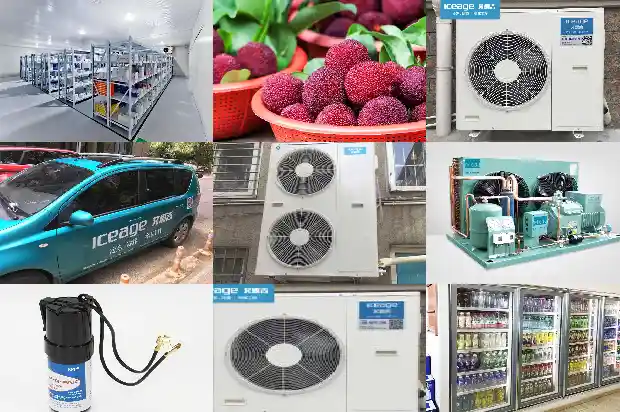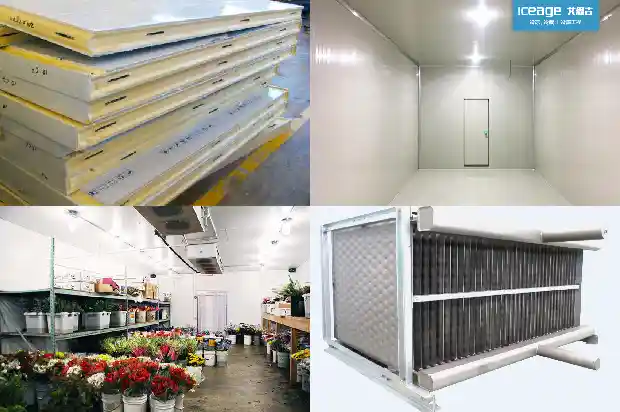Screw Compressor Units: Principles, Design and Selection - Essential Guide for Refrigeration Beginners
2025-02-26
System Schematic Diagram:
Refrigerant Circulation:
Ejector Enthalpy - boosting:
For the same compressor, under the same evaporation and condensation temperatures, the COP value increases by 6% - 8%.
At the same time, the compressor's exhaust temperature drops by 1 - 2 °C, improving the compressor's operating conditions and enhancing its operating reliability.
Ejector Oil Return:
Design and Selection:
Selection Process: Calculate the load of each individual space → Select the terminal → Select the main unit → Check the cooling/heating load → Confirm.
Indoor Load Calculation: Indoor load (W) = Room area (m²) × Unit load (W/m²)
Note: The selection of load indicators needs to consider the actual on - site situation.
Terminal Selection: Select the appropriate terminal form according to conditions such as load, noise, and installation space.
Main Unit Selection: Generally, select the main unit according to a simultaneous - use coefficient of 0.7 - 0.8 for all terminals. When choosing the main unit, it is preferred to select 2 units, and there is no need to consider a backup.
Heating Load Check: It is necessary to check the heating load if there is a heating demand, and no check is required if there is no such demand.
After selecting the main unit and the terminal, check the heating load. If it is satisfied, the selection can be directly confirmed. If not, select the terminal and the main unit according to the heating load and then check the cooling load until both the cooling and heating loads meet the requirements.
Selection Case:
Example: Building Conditions: The construction area of an office building is 13000 m², and the air - conditioned area is 12000 m². Among them, the area of the large conference room is 800 m², the area of the small conference room is 2000 m², and the area of the office area is 9200 m². There is a fresh - air demand and no heating demand.
A. Calculate the cooling load.
a. Estimate according to the air - conditioning cooling load method:
Large conference room: 800 × 200 (W/m²) = 160000W = 160kW
Small conference room: 2000 × 240 (W/m²) = 480000W = 480kW
Office area: 9200 × 120 (W/m²) = 1104000W = 1104kW
Total: 160kW + 480kW + 1104kW = 1744kW
Load when selecting the main unit: 1744kW × 0.70 = 1220.8kW
b. Estimate according to the construction - area method: 13000 × 98W = 1274kW
c. Based on the calculation results of a and b, the cooling load is calculated as 1274kW.
B. Initially select the unit model and quantity:
Check the product design and selection manual and refer to the design requirements.
Installation Key Points:
Installation Environment: The unit should be kept away from fire sources and flammable materials. If it is installed alongside heat - generating devices such as boilers, pay full attention to the impact of heat radiation.
Select a place with a room temperature below 45 °C and good ventilation. Outdoor or open - air installation and storage are not allowed, and installation in an environment with corrosive gases is not permitted.
Choose a place with less dust.
The site should have good lighting for easy maintenance and inspection.
To meet the needs of maintaining, repairing, and cleaning the heat - exchange tubes of the evaporator and condenser, there must be sufficient space for tube - pulling at either end of the unit. In the length direction, it should be equivalent to the length of the evaporator and condenser of the unit.
To facilitate the lifting and maintenance of the machine, leave the space required for the installation, operation, and maintenance of the unit.
The area around the unit and the entire machine room should be fully drainable.
Reserve maintenance space during installation:
Installation Foundation Diagram:
The installation foundation of the unit must be a cement or steel structure. It should be able to bear the operating weight of the machine, and its upper surface should be level. It is better to reserve a drainage groove in the installation foundation of the unit.
Refer to the installation foundation schematic diagram of the unit and place it accurately on the foundation.
Install steel plates and vibration - proof rubber pads. After the unit is installed in place together with the anchor bolts, perform secondary grouting. The anchor bolts are generally installed to protrude approximately 100mm above the installation plane.
Hoisting Schematic Diagram: When hoisting, please operate strictly in accordance with the hoisting markings on the unit.
Refrigerant Circulation:
Ejector Enthalpy - boosting:
For the same compressor, under the same evaporation and condensation temperatures, the COP value increases by 6% - 8%.
At the same time, the compressor's exhaust temperature drops by 1 - 2 °C, improving the compressor's operating conditions and enhancing its operating reliability.
Ejector Oil Return:
Design and Selection:
Selection Process: Calculate the load of each individual space → Select the terminal → Select the main unit → Check the cooling/heating load → Confirm.
Indoor Load Calculation: Indoor load (W) = Room area (m²) × Unit load (W/m²)
Note: The selection of load indicators needs to consider the actual on - site situation.
Terminal Selection: Select the appropriate terminal form according to conditions such as load, noise, and installation space.
Main Unit Selection: Generally, select the main unit according to a simultaneous - use coefficient of 0.7 - 0.8 for all terminals. When choosing the main unit, it is preferred to select 2 units, and there is no need to consider a backup.

Heating Load Check: It is necessary to check the heating load if there is a heating demand, and no check is required if there is no such demand.
After selecting the main unit and the terminal, check the heating load. If it is satisfied, the selection can be directly confirmed. If not, select the terminal and the main unit according to the heating load and then check the cooling load until both the cooling and heating loads meet the requirements.
Selection Case:
Example: Building Conditions: The construction area of an office building is 13000 m², and the air - conditioned area is 12000 m². Among them, the area of the large conference room is 800 m², the area of the small conference room is 2000 m², and the area of the office area is 9200 m². There is a fresh - air demand and no heating demand.
A. Calculate the cooling load.
a. Estimate according to the air - conditioning cooling load method:
Large conference room: 800 × 200 (W/m²) = 160000W = 160kW
Small conference room: 2000 × 240 (W/m²) = 480000W = 480kW
Office area: 9200 × 120 (W/m²) = 1104000W = 1104kW
Total: 160kW + 480kW + 1104kW = 1744kW
Load when selecting the main unit: 1744kW × 0.70 = 1220.8kW
b. Estimate according to the construction - area method: 13000 × 98W = 1274kW
c. Based on the calculation results of a and b, the cooling load is calculated as 1274kW.
B. Initially select the unit model and quantity:
Check the product design and selection manual and refer to the design requirements.
Installation Key Points:
Installation Environment: The unit should be kept away from fire sources and flammable materials. If it is installed alongside heat - generating devices such as boilers, pay full attention to the impact of heat radiation.
Select a place with a room temperature below 45 °C and good ventilation. Outdoor or open - air installation and storage are not allowed, and installation in an environment with corrosive gases is not permitted.
Choose a place with less dust.
The site should have good lighting for easy maintenance and inspection.
To meet the needs of maintaining, repairing, and cleaning the heat - exchange tubes of the evaporator and condenser, there must be sufficient space for tube - pulling at either end of the unit. In the length direction, it should be equivalent to the length of the evaporator and condenser of the unit.
To facilitate the lifting and maintenance of the machine, leave the space required for the installation, operation, and maintenance of the unit.

The area around the unit and the entire machine room should be fully drainable.
Reserve maintenance space during installation:
Installation Foundation Diagram:
The installation foundation of the unit must be a cement or steel structure. It should be able to bear the operating weight of the machine, and its upper surface should be level. It is better to reserve a drainage groove in the installation foundation of the unit.
Refer to the installation foundation schematic diagram of the unit and place it accurately on the foundation.
Install steel plates and vibration - proof rubber pads. After the unit is installed in place together with the anchor bolts, perform secondary grouting. The anchor bolts are generally installed to protrude approximately 100mm above the installation plane.
Hoisting Schematic Diagram: When hoisting, please operate strictly in accordance with the hoisting markings on the unit.

Related Articles
- Analysis of Causes for Compressor Liquid Hammer, Overheating and Pre - heating
- Oil Cooling Methods and Oil - changing Operation Procedures for Screw Compressors
- Have You Encountered the Three Common Problems of Refrigeration Compressors?
- What to Do if the Compressor of a Frozen and Refrigerated Display Cabinet Runs but the Refrigeration Effect Is Poor?
- What to Do if the Compressor of the 【Refrigerated and Frozen Display Cabinet】 Unit Fails to Start?
- Precautions for Using Rotary Refrigeration Compressors
- How to Resolve the Scuffing Issue of Cold Storage Compressors
- Composition and Common Faults of Screw Refrigeration Compressors
- What Are the Causes of Scroll Compressor Damage?
- Do You Know These Four Scenarios That Can Cause Compressor Failures?
- What Are the Reasons for Insufficient Air Output of Screw Air Compressors?
- How to Solve the Problem of Frequent Shutdown and Startup of Cold Storage Compressors?
- How to Schedule Overhauls, Medium - sized and Minor Repairs of Screw Refrigeration Compressors?
- Why Can't Compressors Start Directly? What Are the Advantages of Soft Starters?
- Maintenance Methods for Faults in Screw Refrigeration Air - conditioner Compressors
- Solutions to Common Compressor Failures
- Effective Measures to Prevent Compressor Failures in Industrial Chillers
- Common Faults and Troubleshooting Methods of the Moving Mechanism of Piston Compressors
